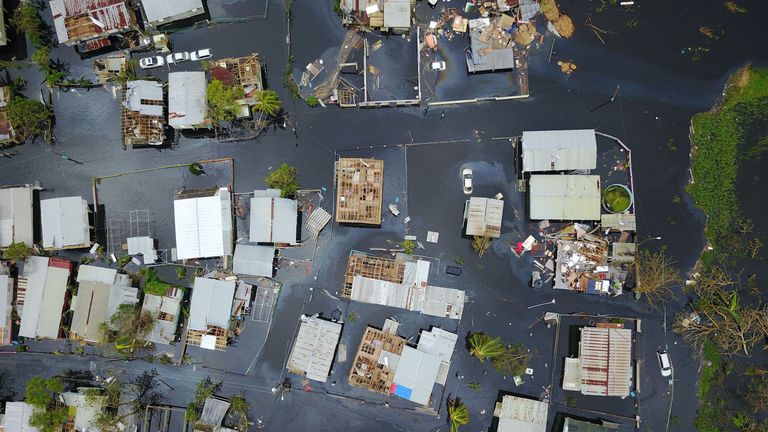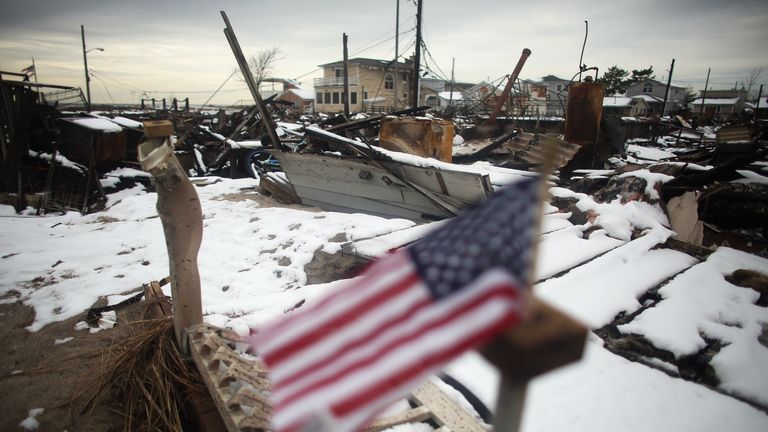From Maria to Dorian: Are hurricanes becoming more devastating than ever?

Wednesday 4 September 2019 13:28, UK
by Tom Acres, technology reporter
Hurricane Dorian has arrived - bringing winds of 185mph to the Bahamas and threatening to bring danger upon parts of the US, including Georgia, South Carolina and Florida.
For many in its path, the force of Dorian will be unprecedented - but is its devastating power part of a trend?
From Katrina to Maria, Sky News looks at whether the category five storm is becoming the norm.
When is hurricane season?
The Atlantic hurricane season peaks from August until October, and comes to an end on 30 November.
The five costliest hurricanes in history - topped by Katrina - all came during this period, with Sandy the latest to form (it did not peak until 25 October 2012).
On average there will be six hurricanes during hurricane season, with three major storms.
What makes a category five storm?
Major storms are anything classified as category three or above on the Saffir-Simpson scale, which measures hurricanes based on the sustained intensity of the winds.
- Category One - 74 to 95mph winds, which can cause some damage to houses and tree branches and may also disrupt some power lines
- Category Two - 96 to 110mph winds, which can cause major damage to homes, uproot trees, and damage power lines enough to cause cuts to electricity
- Category Three - 111 to 129mph winds, even more major damage to homes and trees, with heightened risks of disruption to power and water supplies
- Category Four - 130 to 156mph winds, causing even more damage to homes, trees and supplies, potentially making communities unlivable for weeks
- Category Five - 157mph winds and above, causing catastrophic damage, robbing communities of power for weeks or even months, and making places unlivable
Hurricanes do not have to reach category five levels to be extremely dangerous.
Hurricane Harvey, which made landfall in southern Texas in August 2017, peaked at category four but is tied with Katrina from 2005 as the costliest tropical cyclone on record (not accounting for inflation).
Are we getting more major hurricanes?
The National Hurricane Center says the average number of major hurricanes per year is on the up.
Between 1930 and 1999, there was an average of just over two per year, but the rate has been higher since the turn of the century at just over three per year (Stormfax Weather Almanac).
When it comes to the most intense Atlantic hurricanes on record, as measured by their lowest central pressure (when their winds are strongest), five of the top 10 have come in the last 20 years.
Wilma, October 2005
An incredible plummet in pressure over the course of just 24 hours saw Wilma transform from a tropical storm into a devastating category five hurricane.
It went on to cause damage in resort areas of Cancun, despite weakening to a category four storm, and dropped more than 60 inches of rain on Isla Mujeres before heading across the south of Florida.
Rita, September 2005
Less than a month after Katrina, Rita carried winds of some 180mph as it moved over the Gulf of Mexico.
It weakened to category three by the time it made landfall in Louisiana but still destroyed much of Cameron Parish in the southwest of the state.
Katrina, August 2005
Nobody old enough to remember Katrina will likely ever forget it - it was the most devastating storm of what was an unprecedented hurricane season in 2005 and eventually caused $125bn in damage.
It was particularly catastrophic in New Orleans, and more than 1,800 people died.
Dean, August 2007
Mexico's Yucatan Peninsula is where Dean made landfall.
Fortunately, the category five storm did not claim any lives as the area was sparsely populated, but it later killed 14 people in Haiti and 12 in Mexico.
Maria, September 2017
Puerto Rico was devastated by Maria, which knocked out the entire electrical grid and killed 2,975 people.
Before the death toll was confirmed, Donald Trump had marvelled over the small number of fatalities compared with "a real catastrophe like Katrina" and was criticised for responding half-heartedly to the disaster.
Another recent hurricane, Michael in October 2018, was significant for being the first category five hurricane to make landfall in the US since 1992.
Its 160mph winds was catastrophic for Mexico Beach in Florida, causing more than 70 deaths and $25bn in damage.
Is climate change having an impact?
Experts have been cautious of saying climate change has had an impact on any one specific hurricane, but global warming is helping create conditions in which they can thrive.
Higher water temperatures contribute to a rise in the sea level, which increases the risk of flooding during high tides and storm surges (the global sea level rose by 1.4cm between 1979 and 2017).
Warmer air also holds more atmospheric water vapour, allowing storms to strengthen and unleash more rain.
The increasing warmth of the ocean and air is making hurricanes wetter and slower - a 2019 study by scientists from NASA and the National Oceanic and Atmospheric Administration (NOAA) found that hurricanes are 10% slower than 70 years ago, and 20 to 30% slower over land in the North Atlantic and Western North Pacific.
Hurricane Florence in September 2018 lingered near the North Carolina coast for 53 hours, becoming the wettest cyclone on record for the Carolinas and Hurricane Harvey the previous summer stalled for more than 100 hours in the northern Gulf of Mexico, pumping huge amounts of rain on to Texas.
Ocean temperatures will rise further if the amount of greenhouse gases in the atmosphere continues to increase, and shows the average global sea surface temperature has increased by approximately 0.13C per decade over the past 100 years.
Hurricanes thrive when the water is warmer, hence why they tend to affect the Caribbean, Central America, and southern and eastern parts of the US.
James Baldini, a hurricane expert and professor of earth sciences at Durham University, told Sky News: "It's not rocket science that global warming is causing more warm water, and the warmer the water the stronger the hurricanes become
because there is more moisture in the atmosphere.
"It increases the amount of rainfall associated with them, which causes flooding and makes more powerful storms.
"With temperatures increasing over the last 100 to 150 years, you'd expect storms to get stronger."
So, are hurricanes becoming more devastating?
The overall number of hurricanes has not increased dramatically over recent decades, but there are signs that more of them are developing into seriously powerful and dangerous weather events.
NOAA had been predicting a below average Atlantic hurricane season until fairly late into the summer, only for Dorian to end up becoming the second-strongest Atlantic hurricane on record.
Professor Baldini said: Overall activity hasn't changed very much in general, but activity of the strongest storms seems to be getting greater - and those cause the most destruction and devastation.
"It had been a relatively quiet hurricane season until a week before Dorian and over the course of seven days it changed quite dramatically."
Dorian could end up rivalling other recent storms in terms of damage - and the vast majority of the costliest hurricanes in US history have come in the last 14 years.
Not adjusted for inflation, the National Hurricane Center lists Katrina ($125bn in 2005), Harvey ($125bn in 2017), Maria ($90bn in 2017), Sandy ($65bn in 2012) and Irma ($50bn in 2017) in the top five.














